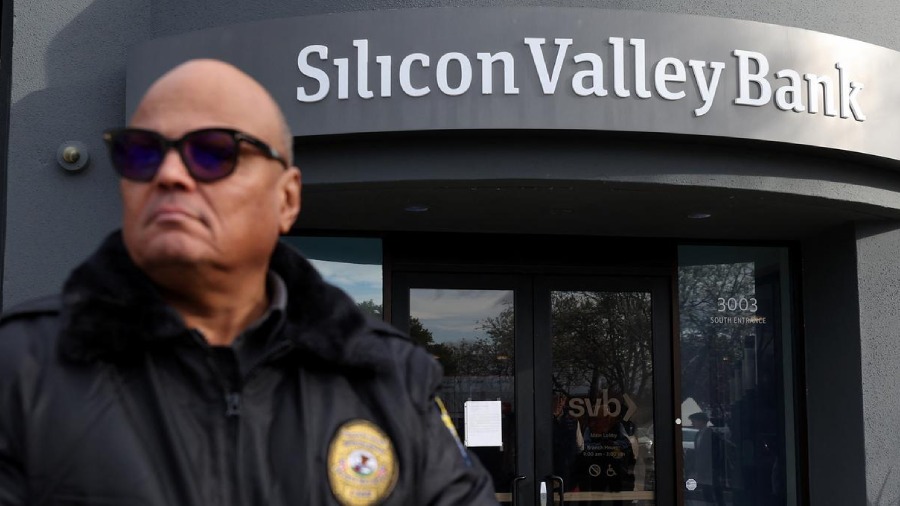The US Federal Reserve on Friday called for greater banking oversight as it released a detailed report into last month's collapse of Silicon Valley Bank (SVB).
SVB was the go-to bank for venture capital firms and technology start-ups for years but failed spectacularly on March 10.
The collapse sparked a crisis of confidence in the banking industry, leading to the failure of New York-based Signature Bank and the merger of Credit Suisse with rival UBS.
Before the failures, regulators had focused mostly on the very biggest US banks that were seen as critical to financial stability, but the vulnerability of the entire banking system to smaller bank failures has forced a rethink.
What did the Fed report say?
The report by Fed Vice Chair for Supervision Michael Barr said it was SVB's own mismanagement of basic risks that was at the root of its downfall.
Executive compensation at the bank was geared toward short-term profits and the stock price, the report found, and there were no incentives tied to risk management.
SVB also had no chief risk officer for roughly a year, during a time when the bank was growing quickly.
The report also gave a scathing assessment of the Fed's own failure to identify problems and push for fixes.
Barr said Fed supervisors did not fully appreciate the problems, delayed their responses even as weaknesses mounted, and "failed to take forceful enough action" after identifying issues at the California lender.
At the time of its failure, SVB had 31 unaddressed citations on its safety and soundness, triple what its peers in the banking sector had, the report said.
Increased capital and liquidity requirements also would have bolstered SVB's resilience, the Fed added.
Barr promised tougher supervision and stricter rules for banks to ensure regulators can more quickly identify risks and vulnerabilities like those that arose at SVB.
The report was also critical of a Trump-era law that rolled back some banking regulations.
The report highlighted how social media sped up the run on SVB's deposits in just a few hours, compared to days for earlier bank runs like those seen in 2008.
Powell, lawmakers react to report
Fed chair Jerome Powell said he welcomed the "self-critical" look at SVB's collapse.
"I agree with and support his recommendations to address our rules and supervisory practices, and I am confident they will lead to a stronger and more resilient banking system," he said.
Patrick McHenry, who chairs the Republican-controlled House Financial Services Committee, welcomed some aspects of Barr's report while criticizing its calls for greater regulation.
"While there are areas identified by Vice Chair Barr on which we agree — including enhancing attention to liquidity issues, especially when a firm is rapidly growing —- the bulk of the report appears to be a justification of Democrats' long-held priorities," he said in a statement.
"Politicizing bank failures does not serve our economy, financial system, or the American people well," he said.
Why did Silicon Valley Bank collapse?
Seeking higher investment returns from its growing deposits, SVB dramatically increased its holdings of long-term bonds during 2021.
But as the Fed raised interest rates throughout 2022 and into 2023, the value of these securities dropped significantly in value, causing unrealized losses.
At the same, some depositors pulled their money from SVB to meet liquidity needs caused by the rate hikes.
A wider bank run began after the bank announced an emergency sale of its bond holdings.
Regulators shut SVB on March 10 after customers withdrew $42 billion (€38 billion) a day earlier and queued to request another $100 billion the following morning.
The historic run triggered massive outflows at other regional banks, including the New York-based Signature Bank (SBNY), which was seized and closed down by regulators two days later.
FDIC releases report on Signature Bank collapse
Also Friday, the Federal Deposit Insurance Corporation (FDIC) published its report into the failure of SBNY.
The FDIC pinned the blame for SBNY's collapse on poor decisions taken by management, the bank's exposure to cryptocurrencies and an overreliance on uninsured deposits.
The report also found that SBNY's failure was also a likely fallout from the failure of SVB, while also admitting to its own failings in overseeing the regional lender.
The report found that "in retrospect, FDIC could have escalated supervisory actions sooner," and that "examination work products could have been timelier and communication with SBNY's board and management could have been more effective."
First Republic Bank under pressure
Although the withdrawals have abated at many banks, a third US regional lender — First Republic Bank in San Francisco — now appears to be in peril, even after receiving a $30 billion infusion of deposits from 11 major banks in March.
The bank's shares have plunged 57% this week after it revealed that depositors withdrew more than $100 billion in the wake of SVB's failure.
Reuters reported Friday that US officials are coordinating urgent talks to rescue First Republic.
The news agency cited three sources familiar with the situation who said private-sector efforts led by the bank's advisers have yet to reach a deal.
Officials view a private-sector deal as preferable to First Republic falling into FDIC receivership, two of the sources said.
CNBC, meanwhile, cited sources as saying that the talks are now focused on preparing to put the bank into FDIC receivership and that such an outcome was likely.
The shares dived more than 40% on Friday to $3.67.











